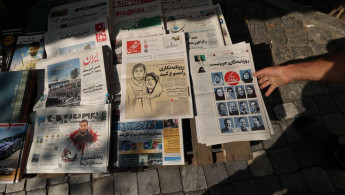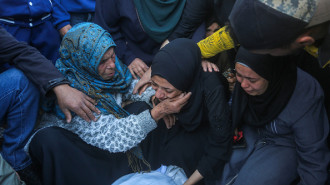Explainer: How authorities use disinformation against Iranian dissidents and opposition media
In October, a report circulated on Farsi social media saying that Iranian officials were escaping the country by five daily charter flights to destinations in the West. The news soon appeared on Faris media broadcasting from Europe and the United States, and even international English outlets such as the Daily Express and Fox News.
That story attracted the opposition media's attention when the anti-establishment protest in Iranian cities peaked. Following the death in custody of 22-year-old Mahsa Amini on 16 September last year, the country was rocked by an unprecedented wave of anti-establishment demonstrations.
The citizens fighting against the oppressive ruling theocracy and the opposition groups abroad cheerfully received the news. But, that excitement was short-lived as it soon became clear that the officials were not only escaping the country but also ready to crack down heavy-handedly on the protests.
Meanwhile, the establishment's media widely covered the stories published about the escape of officials to invalidate the credibility of news outlets reporting against the rulers in Iran.
The Hamshahri daily ridiculed the news on its front page under the headline: "the imaginary flights for officials to escape". On the Faris website, Alef, the principalist legislator Hossein Rajaei Rizi mocked the opposition media and wrote: "what a mess! Based on what these media are reporting, by now, no officials should have remained in the country."
That story did not end there, and in December, Iran International reported that Iranian officials were about to escape to Venezuela. The Saudi-founded satellite news channel, broadcasting only in Farsi, said it received an exclusive report from its sources in Iran.
Disinformation as a means of propaganda
At the same time that opposition media carelessly covered such news, media experts cast doubt on the credibility of those reports and warned about the disinformation campaign deployed by the Iranian authority.
"To me, it was crystal clear that those reports were fake. With few logical questions, any journalist could realise what was behind that information," told The New Arab, an Iranian retired journalist and lecturer at media schools.
"Why Venezuela when they can easily go to Lebanon, Iraq, China or Russia? Moreover, the children of most officials now live in Canada, the United States and European countries, and they can shelter their parents if needed. So why should they go to Venezuela?" he added, clarifying why he doubted the news.
According to this media expert, the news about charter flights to western countries was also a disinformation campaign to undermine the credibility of opposition media.
He believed that the violence deployed by the authorities to suppress the 2022 protests was not as brutal as the level of violence used in suppressing the opposition's demonstrations in June 1981 and the execution of political prisoners in 1988.
"Why should they begin escaping the country before using all means they have? Since the 1979 revolution, the people in power have proven their ability to kill thousands to stay in power. So why should they not do it once again and instead voluntarily give power to their opposition?" he asked.
Spreading false news and refuting that information to discredit the opposition outlets has been one of the practices the Iranian authority has repeatedly used since the emergence of the Farsi satellite news channels and online news websites operating outside the country.
During the 2022 demonstrations, these campaigns were deployed along with traditional propaganda techniques such as installing enormous pro-government murals in cities, censoring the news about anti-government protests and broadcasting the dissidents' forced confessions.
Smear campaigns
The death under torture of Hossein Firouzi, the assassination of a notorious judge Abolghasem Salavati, and the breaking of a prominent activist Hussein Ronaghi's both legs during his arrest were other samples of false news the government spread.
When the opposition outlets published this news, the state-run media broadcast fact-checking reports to refute the opposition groups.
A former editor at BBC Persian, who talked to TNA on condition of anonymity due to organisational restraints, explained that the Iranian government began spreading disinformation when its old censorship techniques became ineffective.
"With the rise of satellite channels and the widespread use of the internet in Iran, the government cannot interrupt the free flow of information with censorship. So, they try to make it difficult to identify false news from the truth," the editor said.
According to this journalist, rumours and information pollution will mislead the audience and create distrust in outlets that challenge the establishment narrative of the truth.
"The other technique they chiefly use on social media is to create enormous amounts of information. A mixture of truth and false info, and with the flood of information, they divert the online arguments in the directions they want," the BBC journalist added.
Hussein Ronaghi, who was targeted by one of these campaigns after his arrest in September, in a post on Telegram, wrote about the methods security services deployed to push his family into a situation in which they became a source of disinformation.
After the violent arrest of Ronaghi in September, sources told his family that the security officers broke both his legs while arresting him. The Ronaghis, worried about their son's health, reported the news to the Farsi media broadcasting outside the country.
"To hide the truth, they did not let me contact my family for 39 days after my arrest," Ronaghi wrote after his release on bail.
"They closed all the ways for me to contact my family and tell them that only my left leg was injured. Why?" he continued.
"Because their disinformation campaign aimed to discredit my family, the journalists and media covering the situation of political prisoners."




 Follow the Middle East's top stories in English at The New Arab on Google News
Follow the Middle East's top stories in English at The New Arab on Google News
![A group of Palestinians, foreign and Israeli activists gather to participated in an olive picking event on the land in the town of Battir, which is under threat of confiscation by Israel in Bethlehem, occupied West Bank on 8 November 2024. [Getty]](/sites/default/files/styles/image_330x185/public/2182930803.jpeg?h=199d8c1f&itok=__0LgGsa)

![People gathered around the rubble of destroyed houses to search for survivors [Getty]](/sites/default/files/styles/image_330x185/public/2024-11/GettyImages-2184733820.jpg?h=199d8c1f&itok=NiM1LO2f)